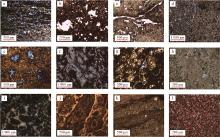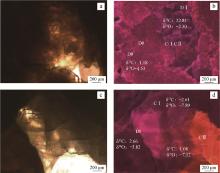

石油与天然气地质 ›› 2020, Vol. 41 ›› Issue (1): 177-188.doi: 10.11743/ogg20200116
周凌方1,2( ), 钱一雄1, 宋晓波3, 曹波3, 尤东华1, 李勇3
), 钱一雄1, 宋晓波3, 曹波3, 尤东华1, 李勇3
收稿日期:2019-08-08
出版日期:2020-02-01
发布日期:2020-01-19
第一作者简介:周凌方(1969-),男,高级工程师,岩石矿物学。E-mail:基金项目:
Lingfang Zhou1,2( ), Yixiong Qian1, Xiaobo Song3, Bo Cao3, Donghua You1, Yong Li3
), Yixiong Qian1, Xiaobo Song3, Bo Cao3, Donghua You1, Yong Li3
Received:2019-08-08
Online:2020-02-01
Published:2020-01-19
Supported by:摘要:
彭州气田雷口坡组四段上亚段的微生物白云岩和微粉晶白云岩是油气主要的储集岩。在此,采用了多种分析手段及统计方法,深入研究了主要岩性的孔隙类型、物性和孔隙结构参数及其与岩相(尤其是微生物岩)、白云石晶体大小等关系,综合划分出4种储集体类型及致密层段(隔层),初步提出了孔隙形成与分布的主控因素。研究表明:具残余藻结构的白云岩占近四分之三多为泥微晶、粉晶白云石;高频旋回中,自下而上,以藻凝块-藻球粒(藻砂屑)-藻纹层-纹层泥晶;晶粒以颗粒-粉(细)晶-微晶-泥晶呈规律变化;中三叠世的干燥-炎热、超盐度和碱性沉积环境利于微生物岩发育,潮下带上部凝块-叠层石至潮间藻纹层-叠层石至潮上带的薄(藻)纹层的向上变浅的米级旋回,导致中、上部往往发育高孔渗带;早期快速的渗透回流白云岩化及大气淡水作用、浅埋藏期的烃类充注及多期构造裂隙对孔隙演化均起了重要的作用。
中图分类号:
表1
彭州气田中三叠统雷四上亚段碳酸盐岩储集空间主要类型及其分类"
| 类型 | 组构选择性 | 种类及特征 |
| A | 组构选择性溶蚀 | 粒间孔IP、晶间孔BC、粒内孔WP、窗格孔FE、遮蔽孔SH,铸模孔MO、与生物有关格架(GF)、微生物席(凝块、核形石、藻纹层-叠层石等)藻菌有关的有机孔OM、膏溶模孔、生物扰动-钻孔-遗迹、潜穴BO-BU等 |
| B | 组构-非组构溶蚀 | 角砾间(溶)孔,窗格溶孔(洞)、膏溶孔洞、各种残余孔(洞)等 |
| C | 裂隙-非组构溶蚀 | 张扭裂隙、压扭剪切(X共轭、雁行排列)、扩溶缝(洞)、溶孔洞(穴)、溶沟-渠道等 |
| D | 微孔隙 | 0.02~10 μm孔隙,泥晶白云石、方解石晶间微孔;凝块、叠层石、藻纹层中微孔、粘土有机质中微孔以及晶体内微孔(石膏、天青石、萤石、黄铁矿等) |

图2
彭州气田中三叠统雷四上亚段代表性碳酸盐岩岩石及孔隙类型 a.YS1井,埋深5 793.95 m,藻纹层-叠层石云岩,明暗纹层,窗格扩溶-格架孔洞,暗色中的藻间溶孔洞较为发育,高孔高渗;b.YS1井,埋深5 793.95 m,残余藻纹层/球粒(50~100 μm,30%~40%)-泥微晶云岩,溶蚀孔洞IP(50~100 μm),微裂隙,面孔率为10%~12%,少量自形白云石(大小0.5~0.8 mm),1/4~1/5充填,高孔高渗;c.YS1井,埋深5 792.94 m,残余藻纹层-球粒云岩,发育扩溶的窗格孔洞,非组构的扩溶缝洞以及与藻纹层、球粒有关的MO-IP(50~200 μm),半自形白云石直面镶嵌,二组开启微裂隙,面孔率一般为2%~4%,局部达6%~8%,高孔高渗;d.YS1井,埋深5 775.13 m,残余藻纹层-球粒云岩与残余凝(斑块)云岩,前者发育窗格(扩溶)孔、晶间(溶)孔;后者发育粒间孔、粒内溶孔及晶间(溶)孔,岩性分界面,受残余藻结构影响,自高孔高渗(左)-中低渗(右);e.SYS1井,埋深6 193.43 m,残余砂屑或鲕粒云岩,模糊的幻影构造,铸模孔、晶间(溶)孔,高孔高渗-中渗;f.SYS1井,埋深6 193.43 m,含粗枝藻的凝块粘结灰岩,发育泡沫绵层构造,粗枝藻或藻凝块中的GF(0.01~0.05 mm),面孔率1%~2%,大量粒间溶孔IP(50~100 μm),1/4~1/5被菱形白云石D1(0.5~0.8 mm)充填,面孔率3%~5%,局部达10%~12%,中孔中渗;g.SYS1井,埋深6 191.87 m,含生屑-残余藻砂屑-球粒粘结的粉晶云岩,发育铸模孔或体腔残余孔隙、晶(粒)间(溶)孔、二组网状开启微裂隙,中孔中渗;h.SYS1井,埋深6 240.96 m,粉细晶白云岩,半自形-自形曲面-直面镶嵌结构,晶间孔,网状开启微裂隙,中低孔高渗;i.SYS1井,埋深6 228.22 m,含有孔虫的藻凝块灰岩,泥晶套,纤状-粒状胶结,少量溶孔及微裂隙,中低孔中低渗; j.SYS1井,埋深6 178.43 m,弱云化核形石灰岩,呈杂乱半球形R,等晶粒状胶结,近圆形-椭园形核形石中残留了生物钻孔或藻、菌(BSR?)斑点或丝带结构,低孔低渗;k.PZ1井,埋深5 766.85 m,残余藻纹层泥粉晶云岩,半自形白云石直面粒状镶嵌,极少量晶间溶孔IP、横微裂隙(0.08~0.10 mm/条)受限于“残余藻纹层”中,局部呈网状扩溶缝孔(50~250 μm),低孔中高渗;l.SYS1井,埋深6 182.93 m,灰质泥粉晶云岩,强烈的去云化作用,约占25%~30%,少量残余晶间孔,低孔低渗"

表2
彭州气田YS1井不同藻结构白云岩、泥粉晶及粉晶云岩孔隙表征参数"
| 岩石类型 | 储集空间 | 孔隙结构 | 排驱压力/MPa | 孔喉半径/μm | 孔隙度/% | 渗透率/(10-3 μm2) |
| 泥微晶白云岩 | 微裂隙和微孔隙 | 纳米孔喉,连通性差 | | |||
| 微粉晶白云岩 | 晶间(溶)孔 | 大孔喉,连通性好 | | | | |
| 藻凝块(藻团块)白云岩 | (藻)格架孔、粒间(溶)孔 | 亚微米孔喉,连通性一般 | | | | |
| 藻球粒(藻砂屑)白云岩 | (藻)格架孔、粒间(溶)孔和微孔隙 | 亚微米孔喉,连通性一般 | | | | |
| 藻纹层藻粘结白云岩 | (藻)格架孔晶间(溶孔) | 大孔喉,连通性好 | | | | |
表3
彭州气田中三叠统雷四上亚段岩性、孔隙类型、物性参数及储集体评价"
| 储层分类 | Ⅰ | Ⅱ | Ⅲ | Ⅳ(致密层) |
| 孔隙度/% | >10 | 10~5 | 5~2 | < 2 |
| 渗透率/(10-3 μm2) | >5 | 5~0.1 | 0.1~0.01 | < 0.01 |
| 平均孔喉半径/μm | >0.3 | 0.3~0.1 | 0.1~0.05 | < 0.05 |
| 主要岩石类型 | 藻纹层-球粒、叠层石云岩、藻纹层-藻粘结云岩及藻砂屑(凝块)云岩、粉细晶云岩 | 藻球粒-藻纹层-藻粘结云岩、粉(细)晶云岩、藻凝块云岩、藻砂屑(凝块)云岩 | 残余藻球粒(或纹层)(含灰)泥粉晶云岩、砂屑(凝块)-藻粘结云岩、含灰粉晶云岩 | 含灰(膏)泥(粉)晶云岩、含云的泥晶灰岩或藻粘结灰岩、含云的生屑泥晶灰岩 |
| 孔隙类型 | 窗格(扩)溶孔洞、藻格架孔、溶孔洞、粒内溶孔、晶间(溶)孔及裂隙、扩溶缝、角砾状溶孔 | 晶间(溶)孔、窗格(扩溶)孔、粒内(间)孔、溶孔(洞)、残留孔隙、微裂隙、扩溶缝 | 晶间孔、粒内孔(微孔隙)、窗格孔、角砾状孔、微裂隙、铸模孔、扩溶缝、残余孔 | 晶(粒)间孔、粒间(内)孔、微孔隙 |
| 其他特征 | 无或较弱的胶结、油斑或油迹 | 白云石、方解石胶结或充填等、少量油斑 | 去云化、白云石、方解石胶结或充填等 | 微生物矿化、白云岩化、去云化、石膏胶结 |
表4
彭州气田PZ1井取心段岩性、微相与沉积旋回、成岩作用及孔隙发育和物性关系"
| 埋深/m | 层段 | 主要岩性 | 微相与旋回 | 成岩作用(胶结类型及比例) | 不同类型孔隙比例 | 实测物性 |
| 5 763.95~ 5 767.77 | T2l4 (3-1) | 有孔虫球粒-砂屑-核形石灰岩 | SMF18, 21, 13 | C0-CⅠ(1%0~15%)、剩余孔隙1%~2%、溶缝孔5%~10%(CⅠ-CⅡ)全部胶结,缝合线白云化(1%~3%),微裂隙孔隙1%~2% | 溶缝31%,BC-IP16%,藻溶孔53%(n=19) | 孔隙度< 2%,个别样品达4%,渗透率< 0.1×10-3 μm2 |
| 5 808.00~ 5 815.30 | T2l4 (3-2) | 砂屑-球粒-叠层石白云质灰岩 | 向上变深, SMF11, 16, 21, 19 | 泥晶套 | 溶缝17%,MO+FE(7.0%),BC-IP27%,藻溶孔27.6%(n=29) | |
| 残余藻球粒-粉晶-泥晶白云岩、灰质白云岩 | 雾心亮边、去白云化、偶含硬石膏、扩溶缝 | 孔隙度为2%~5%,渗透率介于0.01×10-3~0.1×10-3μm2 | ||||
| 5 817.80~ 5 821.00 | T2l4 (3-3) | 粉晶-凝块-球粒-微晶与凝块白云岩夹薄层残余藻球粒灰质白云岩 | 2个向上变深, SMF17,13 | 非组构扩溶缝洞、FE、渗流砂 | 溶缝18.8%,MO+FE(8.3%),BC-IP41.7%,藻溶孔31.25%(n=29) | 孔隙度部分大于5%,渗透率介于0.1×10-3~10×10-3 μm2 |
| 5 821.60~ 5 825.80 | T2l4 (3-4) | 砂屑-凝块-球粒-泥晶白云岩 | 向上变浅, SMF16 | 棘皮(纤状C00+粒状C01:10%)-巨晶CⅡ(20%~30%),云化50%~60%(5 821.88 m),溶孔(CⅠ)+裂隙CⅠ(10%)(5 822.95 m) | 孔隙度为2%~3%,渗透率介于0.1×10-3~1.0×10-3 μm2 | |
| 5 825.80~ 5 828.80 | 含生屑球粒-凝块-粉晶-砂屑灰质白云岩 | 向上变深 | 砂屑-凝块(纤状-粒状C00-C01, 10%),溶孔CⅠ(5%~8%),MO(1%~2%); FE5%~8%,CⅠ,扩溶孔,泡沬状,FE3%~5%(CⅠ1%~2%胶结) | |||
| 粉晶-泥粉晶-粉细晶白云岩 | 强白云化, SMF18 | 晶间孔、晶间溶孔、微裂隙 | 孔隙度为2%~5%,渗透率介于0.1×10-3~1.0×10-3 μm2 |

图9
彭州气田微生物岩储层中凝块白云岩2个世代白云石及孔洞中2期方解石充填CL及微区的同位素值 a, b.SYS1井,埋深6 197.93 m,含棘皮凝块云岩,橙紫红-中等紫红色白云石D0(δ13C为1.18‰,δ18O为-4.53‰),暗紫色DⅠ(δ13C为-2.81‰,δ18O为2.30‰),不发光CⅠ粗晶方解石;c, d:YS1井,埋深5789.12m,残余藻球粒-藻纹层-凝块石云岩,粒状D0发均匀中等或暗紫红色CL,δ13C为2.66‰,δ18O为-5.82‰;大气淡水作用的不发光CⅠ(δ13为-2.61‰,δ18为-7.89‰)和埋藏的发亮艳橙黄红色CⅢ粗晶方解石(δ13为1.08‰,δ18为-7.12‰) "

| 1 | 曾德铭.川西北地区中三叠统雷口坡组储层研究[D].成都:西南石油学院, 2005: 15-45. |
| Zeng Deming.Reservoir study of the Leikoupo Formation of Middle Triassic in northwest Sichuan Province[D]. Chengdu: Southwest Petroleum Institute, 2005: 15-45. | |
| 2 | 王琼仙, 宋晓波, 王东, 等. 川西龙门山前雷口坡组四段储层特征及形成机理[J]. 石油实验地质, 2017, 39 (4): 491- 497. |
| Wang Qiongxian , Song Xiaobo , Wang Dong , et al. Reservoircharacte-ristics and formation mechanism of the 4th member of the Leikoupo Formation in Longmen Mountain Front[J]. Petroleum Geology and Experiment, 2017, 39 (4): 491- 497. | |
| 3 |
高恒逸, 邓美洲, 李勇, 等. 川西彭州地区中三叠统雷口坡组四段储层特征及成岩作用[J]. 海相油气地质, 2018, 23 (1): 37- 46.
doi: 10.3969/j.issn.1672-9854.2018.01.005 |
|
Gao Hengyi , Deng Meizhou , Li Yong , et al. Diagenesis and reservoir characteristics in the Middle Triassic Lei-4 Member of Leikoupo Formation in Pengzhou area of western Sichuan Basin[J]. Marine Origin Petroleum Geology, 2018, 23 (1): 37- 46.
doi: 10.3969/j.issn.1672-9854.2018.01.005 |
|
| 4 | 刘树根, 孙玮, 宋金民, 等. 四川盆地中三叠统雷口坡组天然气勘探的关键地质问题[J]. 天然气地球科学, 2019, 30 (2): 151- 167. |
| Liu Shugen , Sun Wei , Song Jinmin , et al. The key geological problems of natural gas exporation in the Middle Triassic Leikoupo Formation in Sichuan Basin[J]. Natural Gas Geoscience, 2019, 30 (2): 151- 167. | |
| 5 | 孙伟. 龙门山前雷口坡组储层孔隙结构特征及开发评价意义探讨[J]. 地球科学前沿, 2018, 8 (2): 318- 330. |
| Sun Wei . Pore structure characteristics and significance of development evaluation of Leikoupo Formation reservoir in Longmen Mountain Front[J]. Advances in Geosciences, 2018, 8 (2): 318- 330. | |
| 6 | Choquette P W , Pray L C . Geologic nomenclature and classification of porosity in sedimentary carbonates[J]. AAPG Bulletin, 1970, 54 (2): 207- 250. |
| 7 | Lucia F J . Rock-fabric/petrophysical classification of carbonate pore space for reservoir characterization[J]. AAPG Bulletin, 1995, 79 (9): 1275- 1300. |
| 8 |
Hollis C , Vahrenkamp V , Tull S , et al. Pore system characterisation in heterogeneous carbonates:An alternative approach to widely used rock-typing methodologies[J]. Marine and Petroleum Geology, 2010, 27 (4): 772- 793.
doi: 10.1016/j.marpetgeo.2009.12.002 |
| 9 |
赵新伟, 许红. 基于微焦X-CT的碳酸盐岩孔隙结构的精细表征[J]. 特种油气藏, 2016, 23 (1): 127- 131.
doi: 10.3969/j.issn.1006-6535.2016.01.029 |
|
Zhao Xinwei , Xu Hong . Microfocus X-CT based fine characterization of carbonate pore texture[J]. Special Oil&Gas Reservoirs, 2016, 23 (1): 127- 131.
doi: 10.3969/j.issn.1006-6535.2016.01.029 |
|
| 10 | Saller AH , Henderson N . Distribution of porosity and permeability in platform dolomitesInsight from the Permian of West Texas-Reply[J]. AAPG Bulletin, 2001, 85 (3): 530- 532. |
| 11 | 刘宏, 谭秀成, 李凌, 等. 孔隙型碳酸盐岩储集层特征及主控因素-以川西南嘉陵江组嘉5段为例[J]. 石油勘探与开发, 2011, 38 (6): 651- 663. |
| Liu Hong , Tan Xiucheng , Li Ling , et al. Characteristics and main controlling factors of porous carbonate reservoirs:A case from the Jia 5 Member of the Jialingjiang Formation, southwest Sichuan Basin[J]. Petroleum Exploration and Development, 2011, 38 (6): 651- 663. | |
| 12 | Sibley D F , Gregg J M . Classification of dolomite rocks textures[J]. Journal of Sedimentary Petrology, 1987, 57, 967- 975. |
| 13 | 钱一雄, 武恒志, 周凌方, 等. 川西中三叠统雷口坡组三段-四段白云岩特征与成因-来自于岩相学及地球化学的约束[J]. 岩石学报, 2019, 35 (4): 1161- 1180. |
| Qian Yixiong , Wu Hengzhi , Zhou Lingfang , et al. Characteristic and origin of dolomites in the third and fourth member of Leikoupo Formation of The Middle Triassic in NW Sichuan Basin-Constraints in mineralogical&petrographic and geochemical data[J]. Acta Petrologica Sinica, 2019, 35 (4): 1161- 1180. | |
| 14 |
田英姿, 陈克复. 用压汞法和氮吸附法测定孔径分布及比表面积[J]. 中国造纸, 2004, 23 (4): 21- 23.
doi: 10.3969/j.issn.0254-508X.2004.04.007 |
|
Tian Yingzi , Chen Kefu . Determination of pore size distribution and surface area of several materials using mercury porosimetry and gas adsorption[J]. China Pulp&Paper, 2004, 23 (4): 21- 23.
doi: 10.3969/j.issn.0254-508X.2004.04.007 |
|
| 15 | 秦瑞宝, 李雄炎, 刘春成, 等. 碳酸盐岩储层孔隙结构的影响因素与储层参数的定量评价[J]. 地学前缘, 2015, 22 (1): 251- 259. |
| Qin Ruibao , Li Xiongyan , Liu Chuncheng , et al. Influential factors of pore structure and quantitative evaluation of reservoir parameters in carbonate reservoirs[J]. Earth Science Frontiers, 2015, 22 (1): 251- 259. | |
| 16 | 郭振华, 李光辉, 吴蕾, 等. 碳酸盐岩储层孔隙结构评价方法--以土库曼斯坦阿姆河右岸气田为例[J]. 石油学报, 2011, 32 (3): 459- 465. |
| Guo Zhenhua , Li Guanghui , Wu Lei , et al. Pore texture evaluation of carbonate reservoirs in Gasfield A, Turkmenistan[J]. Acta Petrolei Sinica, 2011, 32 (3): 459- 465. | |
| 17 | NdiamihajaS, PadmanabhanE, Ben-AwuahJ, 等. 静态条件下碳酸盐岩三维孔隙网络的溶蚀改造及其对孔隙结构的影响[J]. 石油勘探与开发, 2019, 46 (2): 361- 369. |
| Ndiamihaja S , Padmanabhan E , Ben-Awuah J , et al. Static dissolution-induced 3D pore network modification and its impact on critical pore attributes of carbonate rocks[J]. Petroleum Exploration and Development, 2019, 46 (2): 361- 369. | |
| 18 |
颜其彬, 陈明江, 汪娟, 等. 碳酸盐岩储层渗透率与孔隙度、喉道半径的关系[J]. 天然气工业, 2015, 35 (6): 30- 36.
doi: 10.3787/j.issn.1000-0976.2015.06.004 |
|
Yan Qibin , Chen Mingjiang , Wang Juan , et al. Correlation among permeability, porosity and pore throat radius of carbonate reservoirs[J]. Natural Gas Industry, 2015, 35 (6): 30- 36.
doi: 10.3787/j.issn.1000-0976.2015.06.004 |
|
| 19 | 张翔, 张伟, 靳秀菊, 等. 普光地区碳酸盐岩储层孔隙类型测井识别及孔渗关系[J]. 地球科学, 2016, 41 (12): 2019- 2026. |
| Zhang Xiang , Zhang Wei , Jin Xiuju , et al. Identification ofpore types and study of poroperm relationships based on logging data in Puguang carbonate reservoir[J]. Earth Science, 2016, 41 (12): 2019- 2026. | |
| 20 | 屈海洲, 周子坤, 张云峰, 等. 微生物碳酸盐岩孔隙研究进展[J]. 沉积学报, 2018, 36 (4): 651- 663. |
| Qu Haizhou , Zhou Zikun , Zhang Yunfeng , et al. Research progress of porosity in microbial carbonates[J]. Acta Sedimentologica Sinica, 2018, 36 (4): 651- 663. | |
| 21 |
王龙, KhalidL, MuhammadR, 等. 微生物碳酸盐岩的成因、分类以及问题与展望--来自华北地台寒武系微生物碳酸盐岩研究的启示[J]. 地球科学进展, 2018, 33 (10): 1005- 1023.
doi: 10.11867/j.issn.1001-8166.2018.10.1005. |
|
Wang Long , Khalid L , Muhammad R , et al. The genesis, classification, problems and prospects of microbial carbonates:Implications from the Cambrian carbonate of North China Platform[J]. Advances in Earth Science, 2018, 33 (10): 1005- 1023.
doi: 10.11867/j.issn.1001-8166.2018.10.1005. |
|
| 22 |
Hip K , Haas J , Poros Z , et al. Dolomitization of Triassic microbial mat deposits (Hungary):Origin of microcrystalline dolomite[J]. Sedimentary Geology, 2015, 318, 113- 129.
doi: 10.1016/j.sedgeo.2014.12.002 |
| 23 | 吕修祥, 陈佩佩, 陈坤, 等. 深层碳酸盐岩差异成岩作用对油气分层聚集的影响--以塔里木盆地塔中隆起北斜坡鹰山组为例[J]. 石油与天然气地质, 2019, 40 (5): 957- 971. |
| Lyu Xiuxiang , Chen Peipei , Chen Kun , et al. Effects of differential diagenesis of deep carbonate rocks on hydrocarbon zonation and accumulation:A case study of Yingshan Formation on northern slope of Tazhong uplift, Tarim Basin[J]. Oil&Gas Geology, 2019, 40 (5): 957- 971. | |
| 24 | 王鸣川, 段太忠, 杜秀娟, 等. 沉积相耦合岩石物理类型的孔隙型碳酸盐岩油藏建模方法[J]. 石油实验地质, 2018, 40 (2): 253- 259. |
| Wang Mingchuan , Duan Taizhong , Du Xiujuan , et al. Geological modeling method based on sedimentary facies coupled rock type for porous carbonate reservoirs[J]. Petroleum Geology&Experiment, 2018, 40 (2): 253- 259. | |
| 25 | 刘宇坤, 何生, 何治亮, 等. 碳酸盐岩超压岩石物理模拟实验及超压预测理论模型[J]. 石油与天然气地质, 2019, 40 (4): 716- 724. |
| Liu Yukun , He Sheng , He Zhiliang , et al. The rock physics modeling experiment under overpressure and theoretical model for overpressure prediction in carbonate rocks[J]. Oil&Gas Geology, 2019, 40 (4): 716- 724. | |
| 26 | 王义武, 蒋飞虎, 慕小水, 等. 湖相碳酸盐岩成因及其石油地质意义:以东濮凹陷沙河街组四段为例[J]. 断块油气田, 2018, 25 (5): 568- 572. |
| Wang Yiwu , Jiang Feihu , Mu Xiaoshui , et al. Origin of lacustrine carbonate rocks and its significance to petroleum geology:taking fourth Member of Shahejie Formation in Dongpu Sag as an example[J]. Fault-Block Oil and Gas Field, 2018, 25 (5): 568- 572. | |
| 27 | 赫俊民, 王小垚, 孙建芳, 等. 塔里木盆地塔河地区中-下奥陶统碳酸盐岩储层天然裂缝发育特征及主控因素[J]. 石油与天然气地质, 2019, 40 (5): 1022- 1030. |
| Hao Junmin , Wang Xiaoyao , Sun Jianfang , et al. Characteristics and main controlling factors of natural fractures in the Lower-to-Middle Ordovician carbonate reservoirs in Tahe area, Northern Tarim Basin[J]. Oil&Gas Geology, 2019, 40 (5): 1022- 1030. |
| [1] | 方锐, 蒋裕强, 杨长城, 邓海波, 蒋婵, 洪海涛, 唐松, 谷一凡, 朱讯, 孙莎莎, 蔡光银. 四川盆地侏罗系凉高山组不同岩性组合页岩油赋存状态及可动性[J]. 石油与天然气地质, 2024, 45(3): 752-769. |
| [2] | 何骁, 郑马嘉, 刘勇, 赵群, 石学文, 姜振学, 吴伟, 伍亚, 宁诗坦, 唐相路, 刘达东. 四川盆地“槽-隆”控制下的寒武系筇竹寺组页岩储层特征及其差异性成因[J]. 石油与天然气地质, 2024, 45(2): 420-439. |
| [3] | 张赫驿, 杨帅, 张玺华, 彭瀚霖, 李乾, 陈聪, 高兆龙, 陈安清. 川东地区中二叠统茅口组沉积微相与环境演变[J]. 石油与天然气地质, 2024, 45(2): 457-470. |
| [4] | 潘辉, 蒋裕强, 朱讯, 邓海波, 宋林珂, 王占磊, 李杪, 周亚东, 冯林杰, 袁永亮, 王猛. 河流相致密砂岩气地质甜点评价[J]. 石油与天然气地质, 2024, 45(2): 471-485. |
| [5] | 张宝收, 张本健, 汪华, 陈践发, 刘凯旋, 豆霜, 戴鑫, 陈双玲. 四川盆地金秋气田:一个典型以中生界沉积岩为氦源岩的含氦-富氦气田[J]. 石油与天然气地质, 2024, 45(1): 185-199. |
| [6] | 张自力, 乔艳萍, 豆霜, 李堃宇, 钟原, 武鲁亚, 张宝收, 戴鑫, 金鑫, 王斌, 宋金民. 四川盆地蓬莱气区震旦系灯影组二段岩溶古地貌与控储模式[J]. 石油与天然气地质, 2024, 45(1): 200-214. |
| [7] | 王光付, 李凤霞, 王海波, 周彤, 张亚雄, 王濡岳, 李宁, 陈昱辛, 熊晓菲. 四川盆地不同类型页岩气压裂难点和对策[J]. 石油与天然气地质, 2023, 44(6): 1378-1392. |
| [8] | 胡宗全, 王濡岳, 路菁, 冯动军, 刘粤蛟, 申宝剑, 刘忠宝, 王冠平, 何建华. 陆相页岩及其夹层储集特征对比与差异演化模式[J]. 石油与天然气地质, 2023, 44(6): 1393-1404. |
| [9] | 王红岩, 周尚文, 赵群, 施振生, 刘德勋, 焦鹏飞. 川南地区深层页岩气富集特征、勘探开发进展及展望[J]. 石油与天然气地质, 2023, 44(6): 1430-1441. |
| [10] | 边瑞康, 孙川翔, 聂海宽, 刘珠江, 杜伟, 李沛, 王濡岳. 四川盆地东南部五峰组-龙马溪组深层页岩气藏类型、特征及勘探方向[J]. 石油与天然气地质, 2023, 44(6): 1515-1529. |
| [11] | 李双建, 李智, 张磊, 李英强, 孟宪武, 王海军. 四川盆地川西坳陷三叠系盐下超深层油气成藏条件与勘探方向[J]. 石油与天然气地质, 2023, 44(6): 1555-1567. |
| [12] | 曾溅辉, 张亚雄, 张在振, 乔俊程, 王茂云, 陈冬霞, 姚泾利, 丁景辰, 熊亮, 刘亚洲, 赵伟波, 任克博. 致密砂岩气藏复杂气-水关系形成和分布主控因素及分布模式[J]. 石油与天然气地质, 2023, 44(5): 1067-1083. |
| [13] | 刘昇, 范存辉, 张本健, 张亚, 王尉, 罗冰, 白晓亮. 四川盆地东部中二叠统茅口组孤峰段展布特征及其油气地质意义[J]. 石油与天然气地质, 2023, 44(4): 993-1008. |
| [14] | 吴冬, 邓虎成, 熊亮, 曹凯旋, 董晓霞, 赵勇, 魏力民, 王同, 马若龙. 四川盆地及其周缘下寒武统麦地坪组-筇竹寺组层序充填和演化模式[J]. 石油与天然气地质, 2023, 44(3): 764-777. |
| [15] | 何发岐, 张威, 丁晓琪, 祁壮壮, 李春堂, 孙涵静. 鄂尔多斯盆地乌审旗古隆起对岩溶气藏的控制机理[J]. 石油与天然气地质, 2023, 44(2): 276-291. |
| 阅读次数 | ||||||
|
全文 |
|
|||||
|
摘要 |
|
|||||